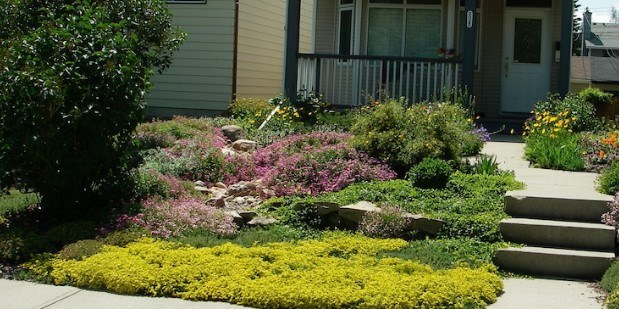As signs have sprung up urging people to be water-wise with their yards and the Town of Cochrane’s license to draw water from the Bow River is set to expire in the next four years, there might not be a better time for residents to consider a less thirsty landscaping option.
It’s an alternative that allows selling the lawnmower at a garage sale.
The decision to abandon the lawn idea and convert to more natural vegetation is a big one, but there is plenty of advice out there and even some financial help for those willing to take the plunge into water-wise landscaping.
The many options include combinations of decorative chips, gravel, perennials, ground cover, shrubs and trees.
Veteran Calgary landscaper, founder of Eco-yards, and author Laureen Rama talked recently in Cochrane about ways to make yards less thirsty by replacing grass, managing rain water, and choosing plants that use less water.
Her presentation, sponsored by the Cochrane Ecological Action Committee, covered the ABCs of converting grass to natural covers in a way that even the most inexperienced landscapers could understand.
A lawn, according to Rama, only soaks up about 10 per cent of the water that a natural landscape absorbs. The other 90 per cent runs off and is essentially wasted.
It’s a topic of importance to her, as she made clear at the outset of her talk.
“I got into landscaping because I wanted people to not have lawns, because they use a lot of water,” she began.
There are essentially two options for getting rid of the lawn: cover over it, or dig the grass out and replace it.
To cover over, the technique is simply to cover existing grass with newspaper, which Rama recommended as a better option than digging out the old sod. It’s cheaper, less work, and if done properly, will do a better job of keeping weeds and grass from re-appearing later.
Rama also outlined the process in detail in her book Eco-Yards, Simple Steps to Earth-Friendly Landscapes.
Newspaper is placed down, at least 15 sheets thick, overlapping six inches (in.). Then it is wetted, and covered with 1 to 2 in. of composted soil to hold it down, covered with 4 in. of mulch, and wetted again.
The newspaper blocks out the light and the mulch blocks air from the grass so it will die, decompose and become organic matter to feed the new plants to come.
Cardboard or old carpeting can be used in lieu of newspaper, but Rama advised that newsprint works the best.
Sod strippers can be rented as an alternative, but they may not go deep enough to take out all the old roots. If a landscaping company needs to be hired to also rototill, the costs can add up.
Pre-digging holes for larger plants or shrubs before laying down the newspaper is a good idea – the holes can be filled with pots to keep them from filling with compost.
Organic mulches are preferable, as they retain more moisture, prevent unwanted plants from growing, and improve the soil.
For those not inclined to do a complete design make-over, Rama mentioned other non-lawn options as well, such as overseeding with Sheep Fescue grass, (which doesn’t require mowing), planting various types of clover, ground covering thyme, or vegetables.
Rebecca Carroll, a water systems technologist with the Town of Cochrane, converted her yard in 2022.
She said outdoor watering can account for up to 50 per cent of a household’s water use in the summer.
As reported by The Eagle last week, the municipality is offering a couple of different types of rebates for residents making their property more water-efficient. The rebate for grass replacement costs in general is up from last year.
“For gardens and yards we have the lawn alternative rebates, which is available for a number of items for things like clover or alternative seeds, hardscapes, rock materials, any sort of ground cover,” Carroll said. “For rocks and things like that, the sky’s the limit.”
Wood mulch is also covered under the rebate program.
Fescue sod is another alternative product that’s native to Cochrane and southern Alberta. It’s a much hardier grass than the traditional Kentucky blue grass.
“That helps hold in moisture – awesome product to have, for sure,” Carroll said.
The mulch rebate has increased from a maximum of $75 to $100 this year, based on 50 per cent of the purchase price.
Residents can receive a 50 per cent rebate on the purchase of rock, drought-tolerant ground cover (micro clover, lawn replacement blends), artificial turf, rubber mulch, and hardscape to a maximum of $150. However, it should be noted concrete slabs do not qualify under the hardscape category.
The lawn alternative rebate is available for Cochrane homes with and without existing landscaping, and material must be purchased in the current calendar year to be eligible for a rebate.
The Town’s website has a complete description of what’s covered under the rebate program.




